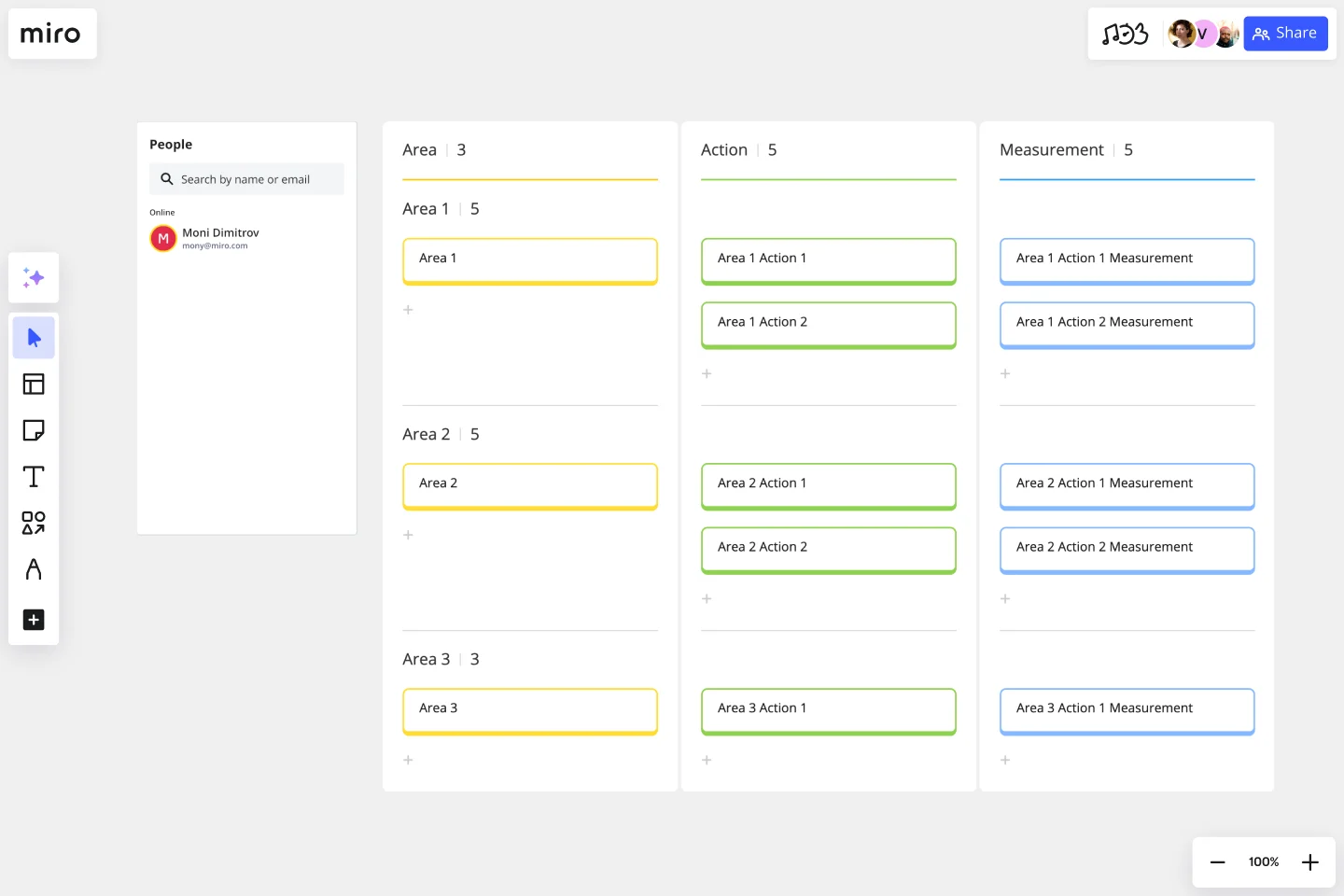Corrective Action Plan Template
Correct for any undesirable actions, outcomes, or behaviors that occur in the workplace. Document everything in a written framework with actionable steps using Miro’s template for corrective action.
About the Corrective Action Plan Template
Once in a while, a manager or HR representative must deliver a corrective action plan to an employee. It’s a difficult conversation, but when inappropriate behavior occurs or job performance fails to meet expectations, the best course of action is to document the infraction. Not only does it help drive the conversation between HR, the manager, and the employee, but it also paves the way for actionable next steps for improvement.
Keep reading to learn more about how to use this simple Corrective Action Plan Template.
What is a corrective action plan?
A corrective action plan takes difficult conversations — regarding behavior or job performance — and puts them into a professional, written framework so that the process, next steps, and details of the conversations are documented. A corrective action plan might include the following:
A write-up of the deficiency (behavioral or performance) and why it has created a disconnect in the expectations of the role.
An HR-approved template describing what is included in the corrective action plan and what steps must be followed.
A process of stop, start, and continue is clearly laid out.
Clarification of roles & responsibilities.
A specification of the ramifications of not following the corrective action plan.
This might seem like a lot of work for a manager or HR team member, but that’s why having an easy-to-use template is just what you need to simplify the tasks!
When to use corrective action plans
Corrective action plans aren’t always negative in nature. Sure, the most common use case might be combating behavior issues, but corrective action can also signal the need for sweeping changes within an organization or team. Put more simply: corrective action can be looked at like quality assurance within individuals or teams that pinpoints a problem, then sets out to fix a specific behavior, task, process, or product.
Create your own corrective action plan
When it comes to corrective action plans, the most important thing is eliminating murky communication, aligning expectations, and providing step-by-step instructions for your employee. Here’s how to create your own, using Miro’s easy pre-made corrective action plan template.
Set a deadline. Set a deadline for completing the steps for corrective action. Also make sure you clearly outline the consequences for not meeting the deadline.
Set priorities and realistic goals: Whether this is an action plan for an individual or a team, setting yourself up for success means setting up priorities and goals.
Document everything: Stakeholders, metrics, dates, expected resolution. Everything should be carefully documented so you have a record of the action plan.
Define the problem! Every corrective action plan must first start with a problem that must be addressed. Make sure you write this down.
Get started with this template right now.
Community Building: A 5 Step Roadmap
Works best for:
Roadmap, Planning, Mapping
Use this five step process for building a community development roadmap.
Executive Summary Template
Works best for:
Leadership, Project Management, Documentation
Pique their curiosity. Get them excited. Inspire them to keep reading, diving further into your proposal details. That’s what a good executive summary has the power to do—and why it’s a crucial opening statement for business plans, project plans, investment proposals, and more. Use this template to create an executive summary that starts building belief, by answering high-level questions that include: What is your project? What are the goals? How will you bring your skills and resources to the project? And who can expect to benefit?
Event Planning Template
Works best for:
Planning, Workshops
Whether you’re planning a product launch, fully remote conference, or milestone event, the Event Planning Template will act as a visual checklist and map for all the details you need to consider before the big day. The Event Planning Template is an adaptable way to make sure the creative and strategic vision of your event doesn’t get lost in the details. By mapping out different sections - from the marketing plan, to the agenda, to snacks and swag for guests — you and your team can focus on the details most important to your functions, and collaborate as needed when overlaps occur.
Example Mapping Template
Works best for:
Product Management, Mapping, Diagrams
To update your product in valuable ways—to recognize problem areas, add features, and make needed improvements—you have to walk in your users’ shoes. Example mapping (or user story mapping) can give you that perspective by helping cross-functional teams identify how users behave in different situations. These user stories are ideal for helping organizations form a development plan for Sprint planning or define the minimum amount of features needed to be valuable to customers.
Business Mindmap
Works best for:
Diagramming
The Business Mindmap template is a visual tool for brainstorming, organizing, and presenting business ideas and concepts. It provides a structured framework for capturing and connecting thoughts, insights, and action items. This template enables teams to explore business strategies, analyze market trends, and develop innovative solutions. By promoting creativity and collaboration, the Business Mindmap empowers teams to generate and communicate actionable business plans effectively.
Company Vision Board Template
Works best for:
Leadership, Org Charts
Find the path to innovation and growth with the Company Vision Board Template. Invite everyone to come together and decide on company direction and goals.
